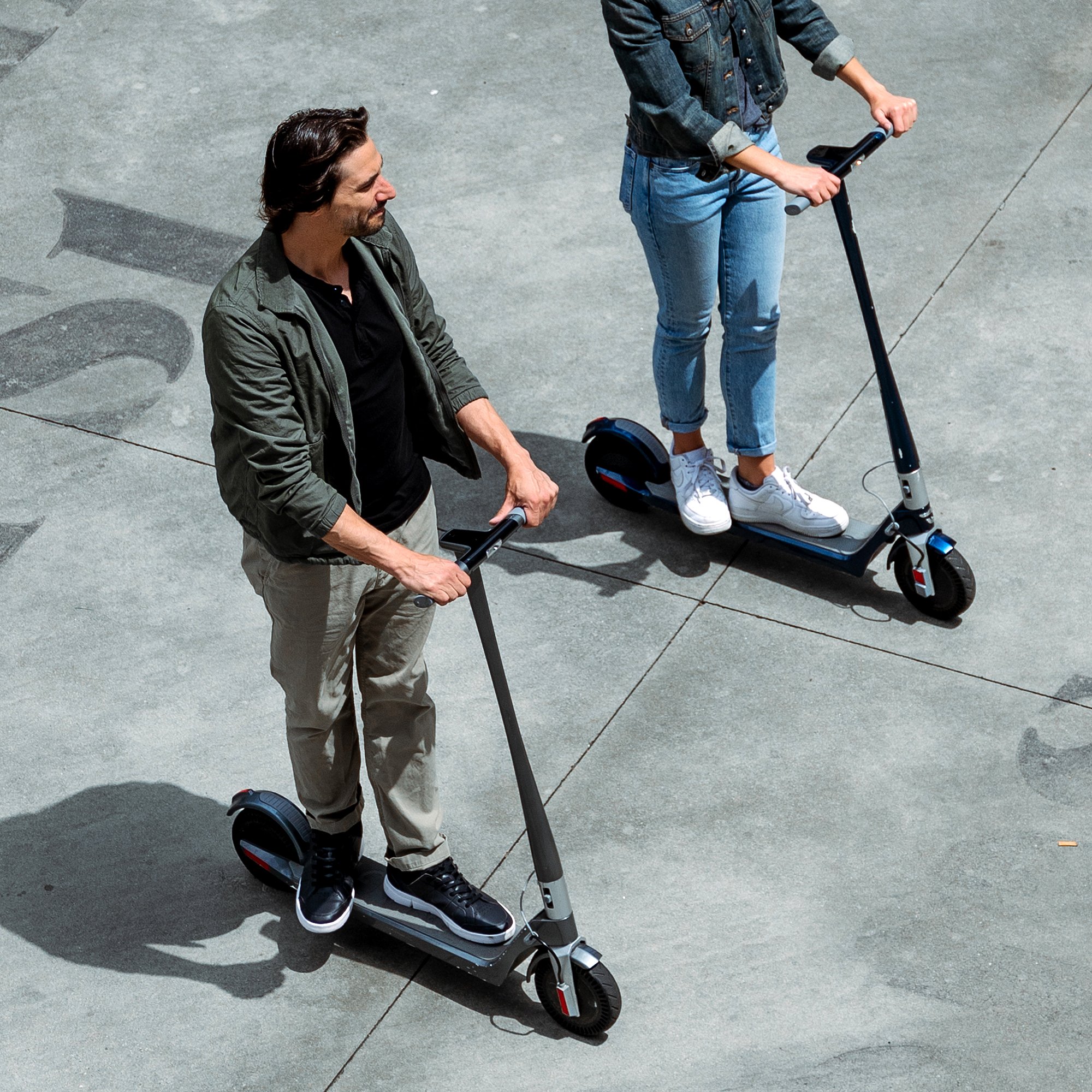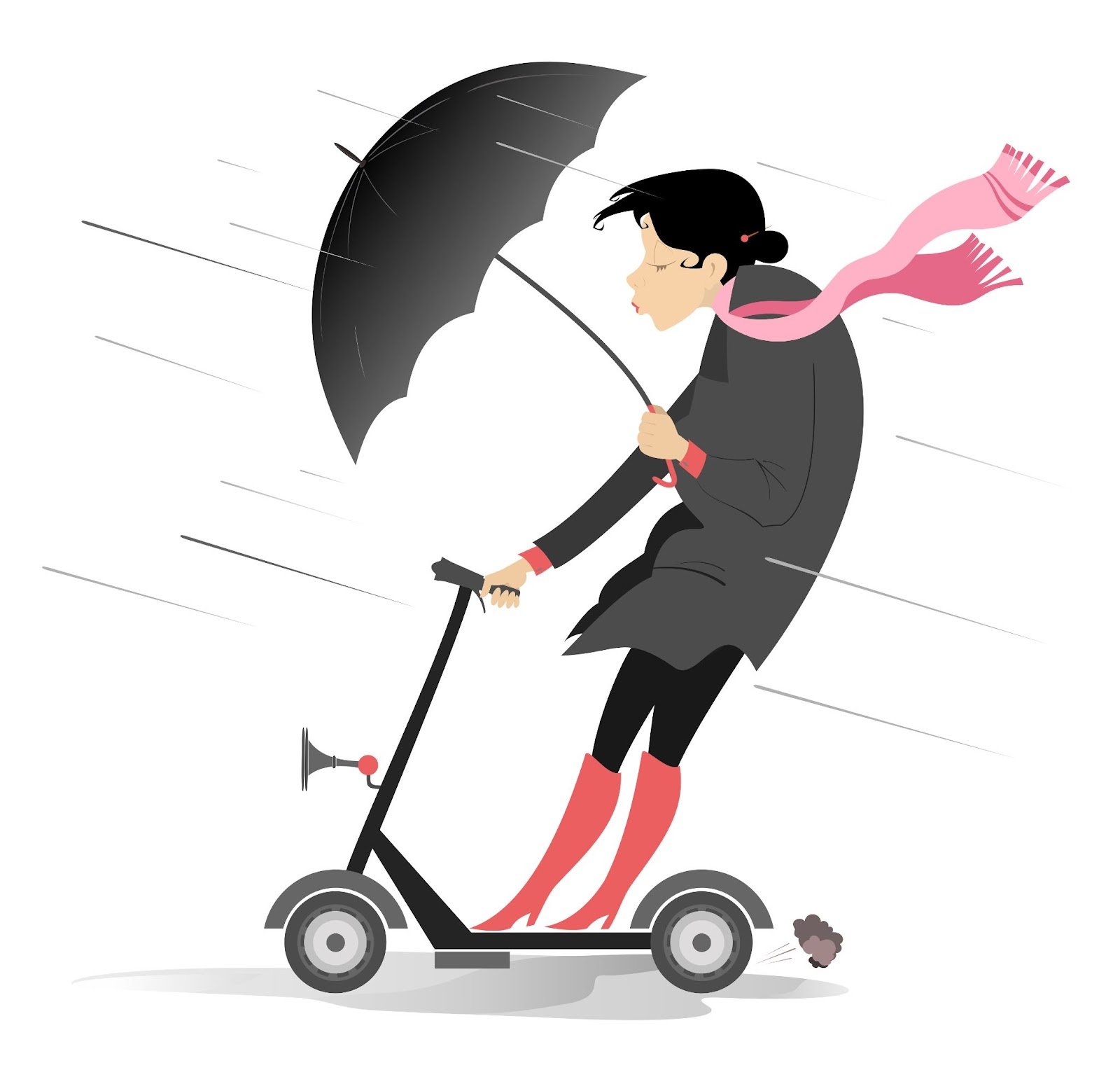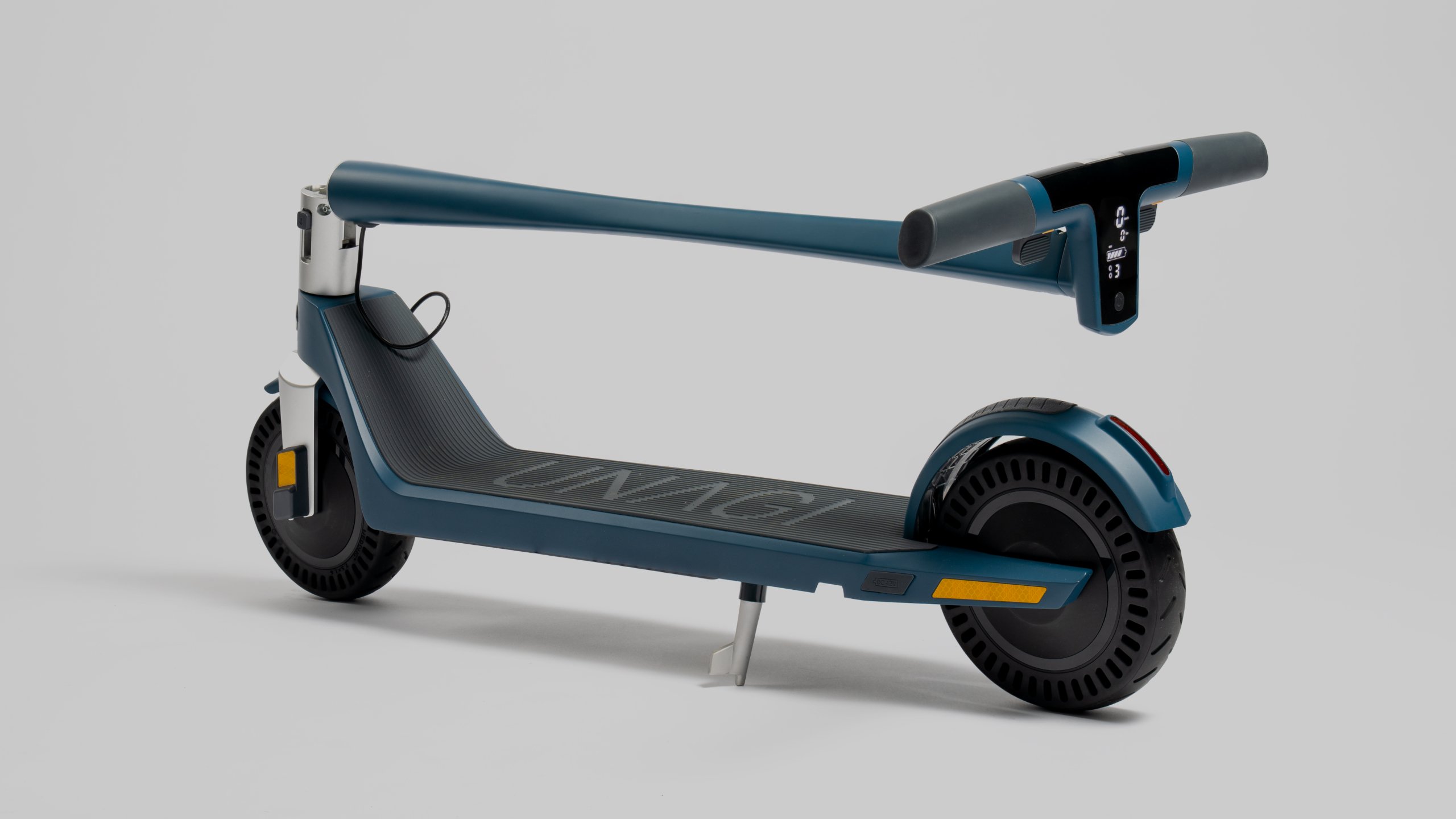Micromobility is here to stay, and it’s changing how we experience urban life for the better. With Unagi’s membership program, you can enjoy all the benefits of a top-tier electric scooter without the sky-high price of ownership or the inconvenience of ride-sharing.
Some riders make it through these wet rides just fine. Others end up with spoilt scooters or worse. The difference often comes down to understanding a few key things:
- How waterproof your electric scooter is (higher is better)
- How hard it's actually raining (drizzle or downpour?)
- How far you need to go (a short trip is safer)
- What other options you realistically have (sometimes there aren't any)
- How much risk you're personally willing to take (because it's your call)
These basic questions will help you weigh the risks before riding your e-scooter in wet conditions.
This guide will explore everything you need to know about riding electric scooters in the rain. We'll cover safety considerations, waterproof ratings, maintenance tips, and how wet weather impacts various scooter components. By the end, you'll have enough information to make your own call — not because there's a clear right answer, but because you'll understand the tradeoffs.

Are Electric Scooters Designed for Rain?
Not really. E-scooters have batteries, motors, and control systems. None of these like getting wet. Water can cause short circuits, corrosion, and other damage that, at best, reduces the scooter's lifespan and, at worst, makes it unusable.
Scooter manufacturers aren't naive, though. They know their products will encounter water. Maybe not full submersion, but at least the occasional splash or unexpected drizzle. So modern scooters are built with some level of water resistance. It's rare to find a e-scooter with zero protection against water. But - and this is crucial - "water-resistant" is not the same as "waterproof". They're designed to handle the occasional splash or light rain. But they're not built for extended rides in heavy rain or plowing through standing water. Even with water-resistant designs, regular wet weather use increases the risk of component failure, especially over time.
How Much Rain Can an Electric Scooter Handle?
To understand how water-resistant an electric scooter is, you need to know about IP ratings. IP stands for Ingress Protection. It's a standard used to define levels of sealing effectiveness against foreign bodies like dust and moisture. In other words, it shows how well the e-scooter can keep dust and water out while protecting its internal components from damage.
An IP rating has two digits:
- The first digit is for solids (like dust) ranging from 0 to 6.
- The second digit is for liquids (ranging from 0 to 9).
For water resistance, we care about the second digit. Here's what the numbers mean:
0: No protection
1: Protected against dripping water
2: Protected against dripping water when tilted up to 15°
3: Protected against spraying water
4: Protected from water splashes from all directions
5: Protected from low-pressure water jets from any direction
6: Protected from high-pressure water jets from any direction
7: Protected from short periods of immersion in water
8: Can withstand long periods of immersion in water
9: Withstands high-pressure, high-temperature water jets (often used in industrial or extreme environments)
Quick Tip: If your e-scooter has 3 or below, forget about riding in wet conditions.
Most electric scooters have an IP rating between IPX4 and IPX6. (The X means the rating for solids wasn't tested or doesn't apply.) Many high-quality, water-resistant electric scooters, like the Unagi Model One, have a water resistance rating of IP54. This means they can be ridden in light rain and will not be negatively affected by the occasional shallow puddle. Some scooters, like low-cost models, aren’t rated for water resistance at all and shouldn’t be ridden in wet conditions. It’s also a good idea to avoid riding shared scooters in the rain, as they’re often poorly maintained and lack reliable water resistance.

What This Means for Riding in the Rain
The electric scooter's IP rating gives you a general idea of how it might handle different levels of rainfall:
- Light rain and puddles: Most scooters with an IP54 or higher rating can manage occasional splashes and light rain.
- Moderate rain: Scooters with an IP65 or IP67 rating can withstand moderate rainfall, but riders should still avoid deep water.
- Heavy rain: Even high-rated water resistant electric scooters may struggle in heavy downpours, as water can seep into seams and gaps.
But even with these ratings, prolonged exposure to water isn't good for the scooter. Think of it like this: a raincoat will keep you dry in a drizzle or even a moderate rain. But you'll eventually get wet if you stand in a downpour for hours. Electric scooters are similar.
Are Electric Scooters Waterproof/Rainproof?
There’s no such thing as a truly waterproof electric scooter or rainproof model. Some models are more water-resistant than others, sure. But water-resistant isn't waterproof. Even "waterproof electric scooters" with decent ingress protection (IP) ratings, like IPX6, aren’t built to withstand extended wet use or submersion without potential issues. The ratings are more for occasional, unexpected exposure to water. However, waterproofing implies complete protection against moisture over extended periods, which no scooter truly offers.
Some manufacturers claim their scooters are waterproof, but be skeptical of these claims, as even highly-rated scooters have vulnerable components that can degrade over time, increasing the risk of water seeping in. Seals, gaskets, and protective layers will wear out with regular exposure to rain, creating openings for water to enter.
When to Avoid Riding Your Scooter in the Rain
While some e-scooters can handle a light drizzle, there are times when you should definitely not ride:
- During thunderstorms: Lightning, strong winds, and heavy rain can create dangerous conditions.
- When visibility is extremely low: If you can't see 400 ft. (120 m) ahead, neither can anyone else. And "anyone else" includes car drivers.
- If the road is flooded: Water deeper than a few inches can damage your electric scooter and pose a safety risk.
In these conditions, consider your options. Maybe it's time to call a ride-share.

What Will Happen If I Ride My Electric Scooter in the Rain? Safety Risks of Riding in the Rain
Even if your electric scooter can handle some rain, Riding an electric scooter in the rain isn't like driving a car in the rain. A lot more can go wrong. Here's what might happen:
Reduced Traction and Slippery Surfaces
Rain creates slippery surfaces, especially on metal, painted lines, or cobblestones. With small wheels and often smooth tires, most electric scooters don’t provide great traction on wet pavement. This can increase the risk of:
- Skidding when braking
- Losing balance when cornering
- Longer braking distances
To mitigate this, riding slowly and avoiding sudden braking or sharp turns is recommended.
Reduced visibility
Rain can reduce visibility for both riders and other road users. Motorists may find it harder to see you in heavy rain or misty conditions, increasing the likelihood of accidents.
Discomfort
Riding in the rain can be cold, wet, and uncomfortable, which can distract you from focusing on the road and responding to hazards.
Drying and Maintenance
After riding in the rain, it’s essential to dry your electric scooter thoroughly. Water tends to collect in crevices and hidden areas, potentially causing issues later if not dried out properly.
Voided warranty
Many manufacturers won't cover water damage under warranty, even for scooters with water resistance ratings. So, if something goes wrong, you're on your own.
Electrical issues
Water might get into the scooter's electrical components. Best case, your scooter stops working until it dries out. Worst case, it causes permanent damage.
Corrosion
Even if the electric scooter works fine after riding in the rain, exposure to moisture can cause rust and corrosion over time, shortening the lifespan of critical parts like bearings and motors.
Tips for Riding an Electric Scooter in the Rain (If You Absolutely Must)
For whatever reason, if you absolutely must ride an electric scooter in the rain, here's how to minimize the damage:
Acceleration, Handling, and Braking
- Reduce your speed to maintain control, especially when braking or cornering.
- Avoid sudden accelerations, and apply brakes gradually to prevent skidding.
- Ensure your scooter has a reliable braking system. For example, the Unagi Model One offers anti-lock electronic brakes, preventing seizing on slippery roads, and a foot brake for backup in case the electronics fail.

Check Your Tires
- Ensure your tires have enough tread depth for good traction on wet surfaces.
- Inflatable tires might give you more grip if you slightly lower the tire pressure. Just remember to re-inflate them later
- Be cautious—pneumatic tires are more prone to flats, and sharp debris can be harder to spot in rainy conditions.
Wear Waterproof Gear
Stay comfortable and dry with:
- Rain jacket and pants
- Waterproof gloves and shoes
- A waterproof cover for your backpack to protect electronics and essentials

Use a Waterproof Cover for the Scooter
- If your electric scooter has a low IP rating, use waterproof covers or accessories to protect vulnerable areas like the dashboard, battery compartment, and charging port from water damage.
Avoid Deep Puddles
- Puddles may conceal potholes or debris that can damage your electric scooter or cause you to lose balance.
- Riding through deep puddles risks flooding the motor or battery compartment, leading to costly repairs.
Improve Visibility
- Wear reflective gear to increase visibility to other road users.
- Ensure your e-scooter’s lights are bright enough for others to see you in rainy weather.
- Rain can seriously impair your vision, especially at higher speeds. Consider a full-face helmet, which provides the best protection in all weather conditions.
Deck and Fenders
- Look for electric scooters with slip-proof decks to prevent your feet from sliding in wet conditions.
- Fenders help keep water and mud off your legs and feet, improving comfort and safety.
These safety tips might help, but they're not magic. You're still taking a risk.
How Do I Protect My Electric Scooter in the Rain?
If you're determined to ride your electric scooter in wet conditions, you can take several steps to improve its water resistance. However, keep in mind that these modifications can be complex, risky and may void your warranty. Here's a comprehensive approach:
Protect the Display
- The display is a common weak point for water resistance.
- Cover it with a plastic sheet, waterproof tape, or a dedicated cover.
- For extra protection, open the display and spray urethane over internal components.
Seal the Deck Gaps and Openings
- Got bathroom silicone or black silicone? Use it. Every gap, every seam - if water can get in, seal it out. Especially around the deck.
- Apply gasket maker to create a tight seal around the deck.
- Use natural-cure silicone, not acid-cure, as the latter can corrode wires.
Waterproof the Motors
- Open the motor casing and spray urethane to shield it from moisture.
- Replace bearings with 2RS dual-seal variants for better water resistance.
- Apply grease inside the motor to prevent corrosion.
Protect the Battery
- Wrap the battery in a lithium fire blanket/ battery bags and secure it with Teflon tape, leaving space for ventilation and wiring at the ends.
- Install caps on charging ports to prevent water ingress.
Address Water Travel
- Water can travel along wires and reach sensitive components.
- Add rubber rings along wires to make the water drop off before it reaches anything important.
Install Fenders or Mudguards
- Use fenders or mudguards to reduce splashes onto essential parts like the motor and battery.
Precautions
- Don’t completely seal the electric scooter—some openings are necessary to allow moisture to escape and prevent internal condensation.
- Be aware that these modifications may void your warranty.
For a more thorough guide, explore our article on Waterproofing Techniques for Electric Scooters.
What to Do If an Electric Scooter Gets Wet
If your electric scooter has an unexpected encounter with water, here's what to do:
Turn It Off Immediately
If the scooter is still on, power it down to avoid potential short circuits.
Dry the Exterior Thoroughly
- Use a towel to dry all visible surfaces, paying close attention to the motor, display, and battery compartment.
- Gently shake the scooter to remove any water trapped in crevices or openings.
Remove the Battery (If Possible)
- If the battery is removable, take it out and dry it separately to prevent electrical damage.
Place It in a Warm, Dry Place
- Store the electric scooter in a warm, dry area with good air circulation.
- Use a fan to help speed up the drying process.
Wait 24-48 Hours Before Powering It On
- Give the scooter 24-48 hours to dry completely—both inside and out—before attempting to turn it back on.
Avoid using the electric scooter until you are certain it is completely dry to prevent short circuits or further damage.
Conclusion: Is Riding an Electric Scooter in the Rain Safe?
So, can you ride electric scooters in the rain? Technically, yes—if your scooter has a good IP rating and it’s only light rain. However, it’s not ideal and comes with risks. The real answer depends on several factors, including your scooter’s water resistance, the intensity of the rain, your comfort level with risk, and how willing you are to deal with potential issues.
For most people, in most situations, riding in the rain is not a good idea. The risks to both you and your electric scooter often outweigh the benefits. You could slide and fall on slippery surfaces, experience short circuits in the controls, motor, or battery, and deal with corrosion and rust over time. And let's not even mention the potential medical bills if things go sideways.
Success in wet weather riding comes down to having the right gear, preparation, and riding techniques. Ride slowly, brake early, avoid puddles, and dry your scooter when you get home.
With these in place, you can confidently handle occasional rainy commutes, but making a habit of riding in wet conditions isn’t advisable. Even the most water-resistant electric scooter can develop issues with regular exposure to rain. In the end, rain riding is a calculated risk. The smart move is to avoid riding in the rain. Take the bus. Work from home. Wait it out.
Do Electric Scooters Brake in the Rain?
Yes, electric scooters can brake in the rain, but not as effectively as in dry conditions. The main issue is traction—even if the scooter's brakes function properly, the e-scooter may slip on wet surfaces, increasing the stopping distance and making it harder to control.
Can I Charge my Electric Scooter After Riding in the Rain?
Only if you enjoy the smell of fried electronics. Wait until the scooter is completely dry before charging it. Moisture in the charging port can cause short circuits or damage to the battery.
Do all Electric Scooters Come with an IP Rating?
Not all electric scooters have IP ratings. Check the product manual or contact the manufacturer to confirm the water resistance level of your scooter.
Which Tires are Best for Riding in the Rain?
Air-filled tires offer better grip, which is crucial in wet conditions.
Should I Lubricate my Electric Scooter After Riding in the Rain?
Yes, it’s a good idea to lubricate bearings and folding joints after riding in wet conditions to prevent rust and ensure smooth operation. Just be careful not to over-lubricate, as this can attract dirt and grime.

Stay current with the latest U.S. electric scooter laws in our 2025 guide. Updated annually since our first comprehensive guide, ensuring you have the most recent state and city regulations to ride responsibly”

The Slack Core 920R is currently the fastest electric scooter in 2025 that you can purchase without the need for pre-order.

Our selection of the best electric scooters 2025 spans the fastest e-scooters to the most portable ones, the ones designed for city riding and off-road, the best scooters for rain, budget electric scooters for students, and more powerful ones for skilled riders.

The Unagi Voyager is the best lightweight electric scooter for adults and teenagers. It is the ultraportable sequel to its predecessor, the Unagi Model One Classic.

If you're wondering whether an electric scooter with a seat is right for you, this is a detailed article that would suit your need.

Understand which personal electric vehicle is best, the choice between an electric bike or electric scooter might already be made for you by some critical factors, including portability and storage capacity.

In the U.S., most states don't require a license. For those that do, they usually just ask for a regular driver's license or a learner's permit.

Yes, you can bring an electric scooter on a plane, but it needs to have a lithium battery smaller than 100 watt-hours, which most don't.

Manufacturers advise against riding electric scooters in the rain. The main reasons are: water can fry the electronics, make the ride dangerous, and void your warranty.














